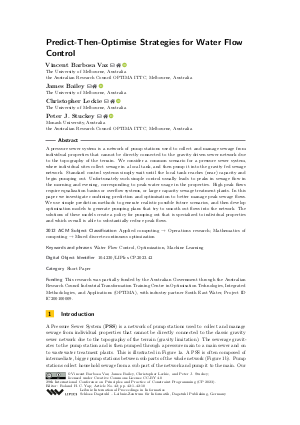Predict-Then-Optimise Strategies for Water Flow Control (Short Paper)
Authors
Vincent Barbosa Vaz  ,
James Bailey
,
James Bailey  ,
Christopher Leckie
,
Christopher Leckie  ,
Peter J. Stuckey
,
Peter J. Stuckey 
-
Part of:
Volume:
29th International Conference on Principles and Practice of Constraint Programming (CP 2023)
Part of: Series: Leibniz International Proceedings in Informatics (LIPIcs)
Part of: Conference: International Conference on Principles and Practice of Constraint Programming (CP) - License:
 Creative Commons Attribution 4.0 International license
Creative Commons Attribution 4.0 International license
- Publication Date: 2023-09-22
File

PDF
LIPIcs.CP.2023.42.pdf
- Filesize: 0.71 MB
- 10 pages
Document Identifiers
Subject Classification
ACM Subject Classification
- Applied computing → Operations research
- Mathematics of computing → Mixed discrete-continuous optimization
Keywords
- Water Flow Control
- Optimization
- Machine Learning
Metrics
- Access Statistics
-
Total Accesses (updated on a weekly basis)
0PDF Downloads0Metadata Views
Abstract
A pressure sewer system is a network of pump stations used to collect and manage sewage from individual properties that cannot be directly connected to the gravity driven sewer network due to the topography of the terrain. We consider a common scenario for a pressure sewer system, where individual sites collect sewage in a local tank, and then pump it into the gravity fed sewage network. Standard control systems simply wait until the local tank reaches (near) capacity and begin pumping out. Unfortunately such simple control usually leads to peaks in sewage flow in the morning and evening, corresponding to peak water usage in the properties. High peak flows require equalization basins or overflow systems, or larger capacity sewage treatment plants. In this paper we investigate combining prediction and optimisation to better manage peak sewage flows. We use simple prediction methods to generate realistic possible future scenarios, and then develop optimisation models to generate pumping plans that try to smooth out flows into the network. The solutions of these models create a policy for pumping out that is specialized to individual properties and which overall is able to substantially reduce peak flows.
Cite As Get BibTex
Vincent Barbosa Vaz, James Bailey, Christopher Leckie, and Peter J. Stuckey. Predict-Then-Optimise Strategies for Water Flow Control (Short Paper). In 29th International Conference on Principles and Practice of Constraint Programming (CP 2023). Leibniz International Proceedings in Informatics (LIPIcs), Volume 280, pp. 42:1-42:10, Schloss Dagstuhl – Leibniz-Zentrum für Informatik (2023)
https://doi.org/10.4230/LIPIcs.CP.2023.42
BibTex
@InProceedings{barbosavaz_et_al:LIPIcs.CP.2023.42,
author = {Barbosa Vaz, Vincent and Bailey, James and Leckie, Christopher and J. Stuckey, Peter},
title = {{Predict-Then-Optimise Strategies for Water Flow Control}},
booktitle = {29th International Conference on Principles and Practice of Constraint Programming (CP 2023)},
pages = {42:1--42:10},
series = {Leibniz International Proceedings in Informatics (LIPIcs)},
ISBN = {978-3-95977-300-3},
ISSN = {1868-8969},
year = {2023},
volume = {280},
editor = {Yap, Roland H. C.},
publisher = {Schloss Dagstuhl -- Leibniz-Zentrum f{\"u}r Informatik},
address = {Dagstuhl, Germany},
URL = {https://drops.dagstuhl.de/entities/document/10.4230/LIPIcs.CP.2023.42},
URN = {urn:nbn:de:0030-drops-190795},
doi = {10.4230/LIPIcs.CP.2023.42},
annote = {Keywords: Water Flow Control, Optimization, Machine Learning}
}
Author Details
- The University of Melbourne, Australia
- the Australian Research Council OPTIMA ITTC, Melbourne, Australia
Funding
This research was partially funded by the Australian Government through the Australian Research Council Industrial Transformation Training Centre in Optimisation Technologies, Integrated Methodologies, and Applications (OPTIMA), with industry partner South East Water, Project ID IC200100009.
References
-
Russell Bent and Pascal Van Hentenryck. Regrets only! Online stochastic optimization under time constraints. In Proceedings of the 19th National Conference on Artifical Intelligence, AAAI'04, pages 501-506. AAAI Press, 2004.

- Russell Bent and Pascal Van Hentenryck. Scenario-based planning for partially dynamic vehicle routing with stochastic customers. Operations Research, 52:977-987, 2004. URL: https://doi.org/10.1287/opre.1040.0124.
-
Russell Bent and Pascal Van Hentenryck. The value of consensus in online stochastic scheduling. In Proceedings of the 14th International Conference on Automated Planning and Scheduling, ICAPS 2004, pages 219-226, 2004.

-
Russell Bent and Pascal Van Hentenryck. Online stochastic optimization without distributions. In ICAPS 2005 - Proceedings of the 15th International Conference on Automated Planning and Scheduling, pages 171-180, 2005.

-
Hyeong Soo Chang, Robert Givan, and Edwin K. P. Chong. On-line scheduling via sampling. In Proceedings of the Fifth International Conference on Artificial Intelligence Planning Systems, AIPS'00, pages 62-71. AAAI Press, 2000.

-
Adam Elmachtoub and Paul Grigas. Smart "predict, then optimize". Management Science, 68(1):9-26, 2022.

- Jayanta Mandi, Emir Demirovic, Peter Stuckey, and Tias Guns. Smart predict-and-optimize for hard combinatorial optimization problems. Proceedings of the AAAI Conference on Artificial Intelligence, 34:1603-1610, 2020. URL: https://doi.org/10.1609/aaai.v34i02.5521.
- Nicholas Nethercote, Peter J. Stuckey, Ralph Becket, Sebastian Brand, Gregory J. Duck, and Guido Tack. Minizinc: Towards a standard CP modelling language. In Christian Bessière, editor, Principles and Practice of Constraint Programming - CP 2007, pages 529-543, Berlin, Heidelberg, 2007. Springer Berlin Heidelberg. URL: https://doi.org/10.1007/978-3-540-74970-7_38.
